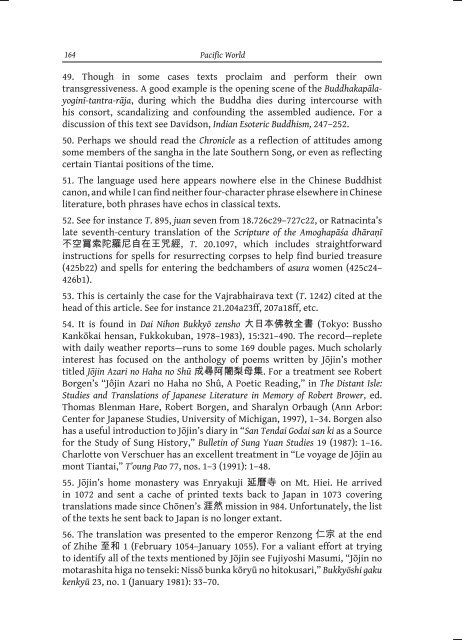Looking for Bhairava - The Institute of Buddhist Studies
Looking for Bhairava - The Institute of Buddhist Studies
Looking for Bhairava - The Institute of Buddhist Studies
- No tags were found...
You also want an ePaper? Increase the reach of your titles
YUMPU automatically turns print PDFs into web optimized ePapers that Google loves.
164Pacific World49. Though in some cases texts proclaim and per<strong>for</strong>m their owntransgressiveness. A good example is the opening scene <strong>of</strong> the Buddhakapālayoginī-tantra-rāja,during which the Buddha dies during intercourse withhis consort, scandalizing and confounding the assembled audience. For adiscussion <strong>of</strong> this text see Davidson, Indian Esoteric Buddhism, 247–252.50. Perhaps we should read the Chronicle as a reflection <strong>of</strong> attitudes amongsome members <strong>of</strong> the sangha in the late Southern Song, or even as reflectingcertain Tiantai positions <strong>of</strong> the time.51. <strong>The</strong> language used here appears nowhere else in the Chinese <strong>Buddhist</strong>canon, and while I can find neither four-character phrase elsewhere in Chineseliterature, both phrases have echos in classical texts.52. See <strong>for</strong> instance T. 895, juan seven from 18.726c29–727c22, or Ratnacinta’slate seventh-century translation <strong>of</strong> the Scripture <strong>of</strong> the Amoghapāśa dhāraṇī不 空 罥 索 陀 羅 尼 自 在 王 咒 經 , T. 20.1097, which includes straight<strong>for</strong>wardinstructions <strong>for</strong> spells <strong>for</strong> resurrecting corpses to help find buried treasure(425b22) and spells <strong>for</strong> entering the bedchambers <strong>of</strong> asura women (425c24–426b1).53. This is certainly the case <strong>for</strong> the Vajrabhairava text (T. 1242) cited at thehead <strong>of</strong> this article. See <strong>for</strong> instance 21.204a23ff, 207a18ff, etc.54. It is found in Dai Nihon Bukkyō zensho 大 日 本 佛 教 全 書 (Tokyo: BusshoKankōkai hensan, Fukkokuban, 1978–1983), 15:321–490. <strong>The</strong> record—repletewith daily weather reports—runs to some 169 double pages. Much scholarlyinterest has focused on the anthology <strong>of</strong> poems written by Jōjin’s mothertitled Jōjin Azari no Haha no Shū 成 尋 阿 闍 梨 母 集 . For a treatment see RobertBorgen’s “Jôjin Azari no Haha no Shû, A Poetic Reading,” in <strong>The</strong> Distant Isle:<strong>Studies</strong> and Translations <strong>of</strong> Japanese Literature in Memory <strong>of</strong> Robert Brower, ed.Thomas Blenman Hare, Robert Borgen, and Sharalyn Orbaugh (Ann Arbor:Center <strong>for</strong> Japanese <strong>Studies</strong>, University <strong>of</strong> Michigan, 1997), 1–34. Borgen alsohas a useful introduction to Jōjin’s diary in “San Tendai Godai san ki as a Source<strong>for</strong> the Study <strong>of</strong> Sung History,” Bulletin <strong>of</strong> Sung Yuan <strong>Studies</strong> 19 (1987): 1–16.Charlotte von Verschuer has an excellent treatment in “Le voyage de Jōjin aumont Tiantai,” T’oung Pao 77, nos. 1–3 (1991): 1–48.55. Jōjin’s home monastery was Enryakuji 延 曆 寺 on Mt. Hiei. He arrivedin 1072 and sent a cache <strong>of</strong> printed texts back to Japan in 1073 coveringtranslations made since Chōnen’s 涯 然 mission in 984. Un<strong>for</strong>tunately, the list<strong>of</strong> the texts he sent back to Japan is no longer extant.56. <strong>The</strong> translation was presented to the emperor Renzong 仁 宗 at the end<strong>of</strong> Zhihe 至 和 1 (February 1054–January 1055). For a valiant ef<strong>for</strong>t at tryingto identify all <strong>of</strong> the texts mentioned by Jōjin see Fujiyoshi Masumi, “Jōjin nomotarashita higa no tenseki: Nissō bunka kōryū no hitokusari,” Bukkyōshi gakukenkyū 23, no. 1 (January 1981): 33–70.
















